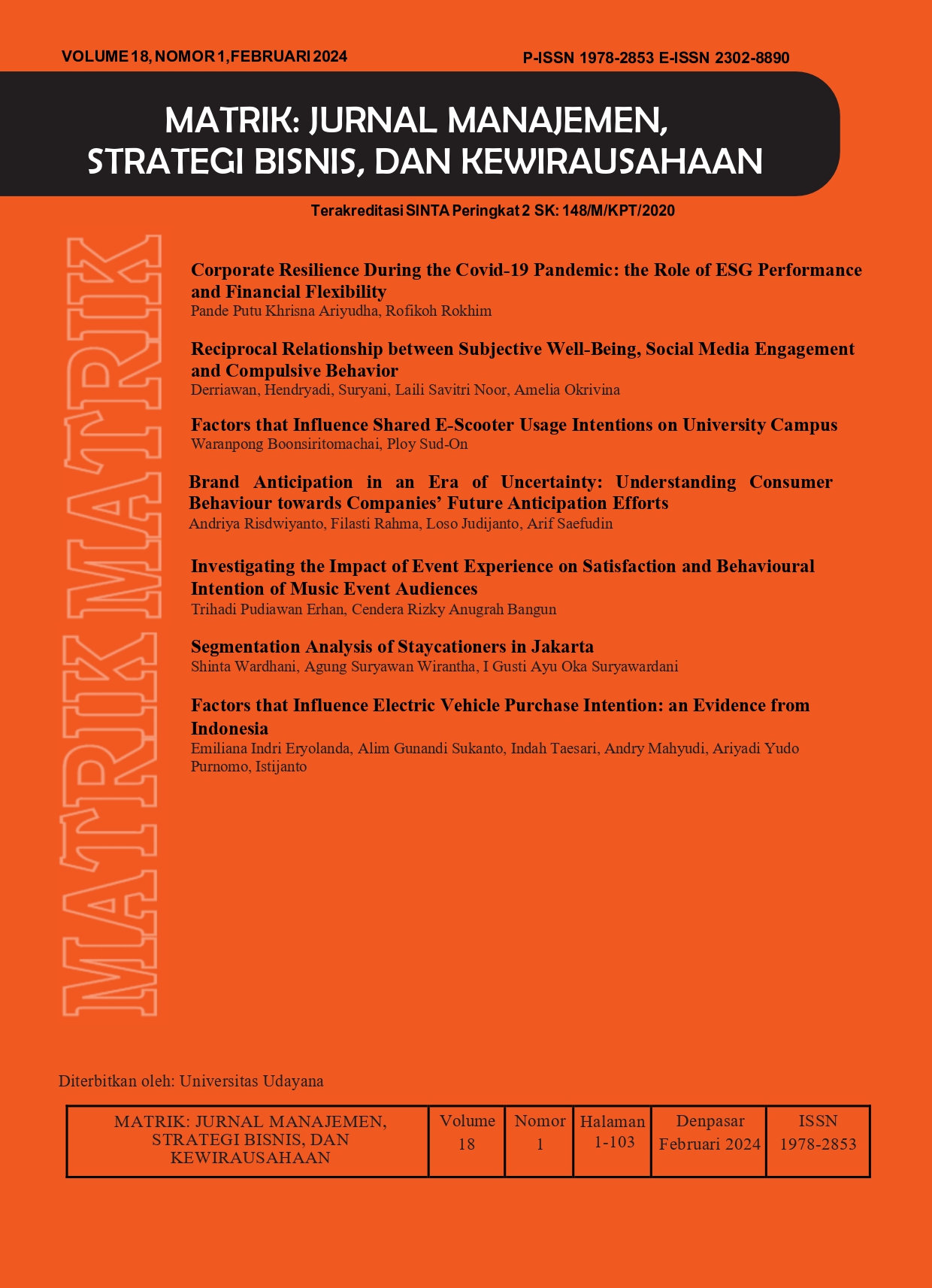Reciprocal Relationship between Subjective Well-Being, Social Media Engagement and Compulsive Buying Behavior
Abstract
This study aimed to investigate the interplay between subjective well-being (SWB), social media engagement (SME), and compulsive buying behavior (CBB). It explored long-term and reciprocal connections among these factors using a longitudinal design with a 2-wave investigation of 226 employees from various sectors in Jakarta, Indonesia. Partial Least Squares Structural Equation Modeling (PLS-SEM) cross-lagged analysis found that SWB at Time 1/Time 2 negatively predicted SME and CBB at the same times, indicating long-term influences. Additionally, SME at Time 1 and CBB at Time 2 significantly predicted SWB at Time 2. The study also found a positive relationship between SME and CBB at both times. This research contributes to the literature by empirically examining the reciprocal relationship among SWB, SME, and CBB, focusing on the association between SWB and CBB.
Keyword: compulsive buying behavior; reciprocal relationship; social media engagement; subjective well-being; longitudinal
Downloads
References
Aragoncillo, L., & Orus, C. (2018). Impulse buying behaviour: an online-offline comparative and the impact of social media. Spanish Journal of Marketing - ESIC, 22(1), 42–62. https://doi.org/10.1108/SJME-03-2018-007
Aydin, D., Selvi, Y., Kandeger, A., & Boysan, M. (2021). The relationship of consumers’ compulsive buying behavior with biological rhythm, impulsivity, and fear of missing out. Biological Rhythm Research, 52(10), 1514–1522. https://doi.org/10.1080/09291016.2019.1654203
Barry, C. T., Moran-Miller, K., Levy, H. F., & Gray, T. (2022). Social media engagement, perceptions of social media costs and benefits, and well-being in college student-athletes. Journal of American College Health, 1–10. https://doi.org/10.1080/07448481.2022.2142797
Cheng, G., He, S., He, Q., Xie, X., Tian, G., Jiang, N., Li, C., Min, X., Li, R., Shi, Y., Zhou, T., & Yan, Y. (2022). Gender and residence differences in the association between social support and subjective well-being among Chinese oldest-old: A national longitudinal study. Archives of Gerontology and Geriatrics, 98, 104545. https://doi.org/10.1016/j.archger.2021.104545
Darrat, A. A., Darrat, M. A., & Darrat, M. A. (2023). Does wanting more lead to losing control? Examining the psychological drivers of compulsive buying. Young Consumers, 24(1), 56–73. https://doi.org/10.1108/YC-01-2022-1453
Diener, E., Suh, E. M., Lucas, R. E., & Smith, H. L. (1999). Subjective well-being: Three decades of progress. Psychological Bulletin, 125, 276–302.
Durayappah, A. (2011). The 3P Model: A General Theory of Subjective Well-Being. Journal of Happiness Studies, 12(4), 681–716. https://doi.org/10.1007/s10902-010-9223-9
Ferman, M., & Benli, B. (2019). The effect of cultural dimensions on conspicuous consumption and online compulsive buying behavior : a comparative study among Turkish and American consumers. Pressacademia, 6(2), 103–127. https://doi.org/10.17261/Pressacademia.2019.1038
Festinger, L. (1954). A Theory of Social Comparison Processes. Human Relations, 7(2), 117–140. https://doi.org/10.1177/001872675400700202
Hair, J. F., Howard, M. C., & Nitzl, C. (2020). Assessing measurement model quality in PLS-SEM using confirmatory composite analysis. Journal of Business Research, 109, 101–110. https://doi.org/https://doi.org/10.1016/j.jbusres.2019.11.069
Hair, J. F., Risher, J. J., Sarstedt, M., & Ringle, C. M. (2019). When to use and how to report the results of PLS-SEM. European Business Review, 31(1), 2–24. https://doi.org/10.1108/EBR-11-2018-0203
Hendryadi, H., Puspita, N., Endit, I., Suryani, S., Kusumaningrum, H., Cahyadi, A., Islam, U., & Antasari, N. (2022). Evaluation of Loneliness , Social Self-efficacy , and Burnout Relationship among Islamic University Students. Indonesian Journal of Islamic Education Studies, 5(December 2022), 162–179. https://doi.org/10.1037/pag0000287.3
Henseler, J., Ringle, C. M., & Sarstedt, M. (2016). Testing measurement invariance of composites using partial least squares. International Marketing Review, 33(3), 405–431. https://doi.org/10.1108/IMR-09-2014-0304
Jarman, H. K., Marques, M. D., McLean, S. A., Slater, A., & Paxton, S. J. (2021). Social media, body satisfaction and well-being among adolescents: A mediation model of appearance-ideal internalization and comparison. Body Image, 36, 139–148. https://doi.org/10.1016/j.bodyim.2020.11.005
Khan, R., Murtaza, G., Neveu, J. P., & Newman, A. (2022). Reciprocal relationship between workplace incivility and deviant silence—The moderating role of moral attentiveness. Applied Psychology, 71(1), 174–196. https://doi.org/10.1111/apps.12316
Kong, F., Yang, K., Yan, W., & Li, X. (2021). How Does Trait Gratitude Relate to Subjective Well-Being in Chinese Adolescents? The Mediating Role of Resilience and Social Support. Journal of Happiness Studies, 22(4), 1611–1622. https://doi.org/10.1007/s10902-020-00286-w
Korkmaz, S., & Seyhan, F. (2021). The effect of social media on impulse buying behavior during the covid 19 pandemic. International Journal of Health Management and Tourism, 6(3), 621–646. https://doi.org/10.31201/ijhmt.994064
Maccarrone‐Eaglen, A., & Schofield, P. (2023). The influence of social media addiction on compulsive buying behaviour: A comparative analysis of LGBT and heterosexual consumers. Journal of Consumer Behaviour, 22(1), 98–121. https://doi.org/10.1002/cb.2115
Mariano, T. E., Nobrega, J. M., Pimentel, C. E., Paiva, T. T., & Alves, T. P. (2019). Evidências Psicométricas do Questionário de Engajamento em Mídias Sociais. Revista de Psicologia Da IMED, 11(2), 115. https://doi.org/10.18256/2175-5027.2019.v11i2.3303
Mason, M. C., Zamparo, G., Marini, A., & Ameen, N. (2022). Glued to your phone? Generation Z’s smartphone addiction and online compulsive buying. Computers in Human Behavior, 136, 107404. https://doi.org/10.1016/j.chb.2022.107404
Mehrabian, A., & Russell, J. A. (1974). An approach to environmental psychology. The Massachusetts Institute of Technology.
Min, Y., & Tan, C. C. (2022). Research and Application of Compulsive Buying Behaviors of Consumers in E-Commerce Livestreaming on Big Data. Human-Centric Intelligent Systems, 2(3–4), 113–123. https://doi.org/10.1007/s44230-022-00010-2
Moon, M. A., Faheem, S., & Farooq, A. (2022). I, me, and my everything: Self conceptual traits and compulsive buying behavior. Journal of Retailing and Consumer Services, 68, 103075. https://doi.org/10.1016/j.jretconser.2022.103075
Müller, A., Laskowski, N. M., Wegmann, E., Steins-Loeber, S., & Brand, M. (2021). Problematic Online Buying-Shopping: Is it Time to Considering the Concept of an Online Subtype of Compulsive Buying-Shopping Disorder or a Specific Internet-Use Disorder? Current Addiction Reports, 8(4), 494–499. https://doi.org/10.1007/s40429-021-00395-3
Müller, A., Mitchell, J. E., & de Zwaan, M. (2015). Compulsive buying. The American Journal on Addictions, 24(2), 132–137. https://doi.org/10.1111/ajad.12111
Mulyono, K. B., & Rusdarti, R. (2020). How psychological factors boost compulsive buying behavior in digital era. International Journal of Social Economics, 47(3), 334–349. https://doi.org/10.1108/IJSE-10-2019-0652
O’Guinn, T. C., & Faber, R. J. (1989). Compulsive Buying: A Phenomenological Exploration. Journal of Consumer Research, 16(2), 147. https://doi.org/10.1086/209204
Olsen, S. O., Khoi, N. H., & Tuu, H. H. (2022). The “Well-Being” and “Ill-Being” of Online Impulsive and Compulsive Buying on Life Satisfaction: The Role of Self-Esteem and Harmony in Life. Journal of Macromarketing, 42(1), 128–145. https://doi.org/10.1177/02761467211048751
Orben, A., & Przybylski, A. K. (2019). The association between adolescent well-being and digital technology use. Nature Human Behaviour, 3(2), 173–182. https://doi.org/10.1038/s41562-018-0506-1
Orsolini, L., Volpe, U., Albert, U., Carmassi, C., Carrà, G., Cirulli, F., Dell’Osso, B., Del Vecchio, V., Di Nicola, M., Giallonardo, V., Luciano, M., Menculini, G., Nanni, M. G., Pompili, M., Sani, G., Sampogna, G., Tortorella, A., & Fiorillo, A. (2022). Use of social network as a coping strategy for depression among young people during the COVID-19 lockdown: findings from the COMET collaborative study. Annals of General Psychiatry, 21(1), 44. https://doi.org/10.1186/s12991-022-00419-w
Ortiz Alvarado, N. B., Rodríguez Ontiveros, M., & Quintanilla Domínguez, C. (2020). Exploring Emotional Well-Being in Facebook as a Driver of Impulsive Buying: A Cross-Cultural Approach. Journal of International Consumer Marketing, 32(5), 400–415. https://doi.org/10.1080/08961530.2020.1722979
Ostic, D., Qalati, S. A., Barbosa, B., Shah, S. M. M., Galvan Vela, E., Herzallah, A. M., & Liu, F. (2021). Effects of Social Media Use on Psychological Well-Being: A Mediated Model. Frontiers in Psychology, 12. https://doi.org/10.3389/fpsyg.2021.678766
Podsakoff, P. M., MacKenzie, S. B., Lee, J. Y., & Podsakoff, N. P. (2003). Common Method Biases in Behavioral Research: A Critical Review of the Literature and Recommended Remedies. Journal of Applied Psychology, 88(5), 879–903. https://doi.org/10.1037/0021-9010.88.5.879
Podsakoff, P. M., MacKenzie, S. B., & Podsakoff, N. P. (2012). Sources of Method Bias in Social Science Research and Recommendations on How to Control It. Annual Review of Psychology, 63(1), 539–569. https://doi.org/10.1146/annurev-psych-120710-100452
Prati, G., Albanesi, C., & Pietrantoni, L. (2016). The Reciprocal Relationship between Sense of Community and Social Well-Being: A Cross-Lagged Panel Analysis. Social Indicators Research, 127(3), 1321–1332. https://doi.org/10.1007/s11205-015-1012-8
Przybylski, A. K., Murayama, K., DeHaan, C. R., & Gladwell, V. (2013). Motivational, emotional, and behavioral correlates of fear of missing out. Computers in Human Behavior, 29(4), 1841–1848. https://doi.org/10.1016/j.chb.2013.02.014
Reer, F., Tang, W. Y., & Quandt, T. (2019). Psychosocial well-being and social media engagement: The mediating roles of social comparison orientation and fear of missing out. New Media & Society, 21(7), 1486–1505. https://doi.org/10.1177/1461444818823719
Ridgway, N. M., Kukar-Kinney, M., & Monroe, K. B. (2008). An Expanded Conceptualization and a New Measure of Compulsive Buying. Journal of Consumer Research, 35(4), 622–639. https://doi.org/10.1086/591108
She, L., Rasiah, R., Waheed, H., & Pahlevan Sharif, S. (2021). Excessive use of social networking sites and financial well-being among young adults: the mediating role of online compulsive buying. Young Consumers, 22(2), 272–289. https://doi.org/10.1108/YC-11-2020-1252
Silvera, D. H., Lavack, A. M., & Kropp, F. (2008). Impulse buying: the role of affect, social influence, and subjective wellbeing. Journal of Consumer Marketing, 25(1), 23–33. https://doi.org/10.1108/07363760810845381
Su, T., Tian, L., & Huebner, E. S. (2021). The reciprocal relations among prosocial behavior, satisfaction of relatedness needs at school, and subjective well-being in school: A three-wave cross-lagged study among Chinese elementary school students. Current Psychology, 40(8), 3734–3746. https://doi.org/10.1007/s12144-019-00323-9
Suresh, A. S., & Biswas, A. (2020). A Study of Factors of Internet Addiction and Its Impact on Online Compulsive Buying Behaviour: Indian Millennial Perspective. Global Business Review, 21(6), 1448–1465. https://doi.org/10.1177/0972150919857011
Szymkowiak, A., Gaczek, P., & Padma, P. (2021). Impulse buying in hospitality: The role of content posted by social media influencers. Journal of Vacation Marketing, 27(4), 385–399. https://doi.org/10.1177/13567667211003216
Tarka, P. (2020). Influence of Materialism on Compulsive Buying Behavior: General Similarities and Differences Related to Studies on Young Adult Consumers in Poland and US. Journal of International Consumer Marketing, 32(3), 243–267. https://doi.org/10.1080/08961530.2019.1695240
Tarka, P., & Kukar-Kinney, M. (2022). Compulsive buying among young consumers in Eastern Europe: a two-study approach to scale adaptation and validation. Journal of Consumer Marketing, 39(1), 106–120. https://doi.org/10.1108/JCM-05-2020-3833
Tarka, P., Kukar-Kinney, M., & Harnish, R. J. (2022). Consumers’ personality and compulsive buying behavior: The role of hedonistic shopping experiences and gender in mediating-moderating relationships. Journal of Retailing and Consumer Services, 64, 102802. https://doi.org/10.1016/j.jretconser.2021.102802
Topp, C. W., Østergaard, S. D., Søndergaard, S., & Bech, P. (2015). The WHO-5 Well-Being Index: A Systematic Review of the Literature. Psychotherapy and Psychosomatics, 84(3), 167–176. https://doi.org/10.1159/000376585
Wheatley, D., & Buglass, S. L. (2019). Social network engagement and subjective well‐being: a life‐course perspective. The British Journal of Sociology, 70(5), 1971–1995. https://doi.org/10.1111/1468-4446.12644
Wolfers, L. N., & Utz, S. (2022). Social media use, stress, and coping. Current Opinion in Psychology, 45, 101305. https://doi.org/10.1016/j.copsyc.2022.101305
Worsley, J. D., McIntyre, J. C., Bentall, R. P., & Corcoran, R. (2018). Childhood maltreatment and problematic social media use: The role of attachment and depression. Psychiatry Research, 267, 88–93. https://doi.org/10.1016/j.psychres.2018.05.023
Xu, C., Unger, A., Bi, C., Papastamatelou, J., & Raab, G. (2022). The influence of Internet shopping and use of credit cards on gender differences in compulsive buying. Journal of Internet and Digital Economics, 2(1), 27–45. https://doi.org/10.1108/JIDE-11-2021-0017
Zafar, A. U., Qiu, J., Li, Y., Wang, J., & Shahzad, M. (2021). The impact of social media celebrities’ posts and contextual interactions on impulse buying in social commerce. Computers in Human Behavior, 115, 106178. https://doi.org/10.1016/j.chb.2019.106178
Zhang, C., Brook, J. S., Leukefeld, C. G., De La Rosa, M., & Brook, D. W. (2017). Compulsive buying and quality of life: An estimate of the monetary cost of compulsive buying among adults in early midlife. Psychiatry Research, 252, 208–214. https://doi.org/10.1016/j.psychres.2017.03.007
 This work is licensed under a Creative Commons Attribution-ShareAlike 4.0 International License.
This work is licensed under a Creative Commons Attribution-ShareAlike 4.0 International License.

















